Air heaters: how to heat a car or a construction tarmac
An efficient heating system is necessary not only for residential buildings, industrial complexes and commercial buildings. Sometimes it is necessary to provide heating for the passenger compartment or the body of a car, a construction trailer or other temporary premises of small size. Here air heaters come to the rescue: Planar, Webasto, Airtronic and others.
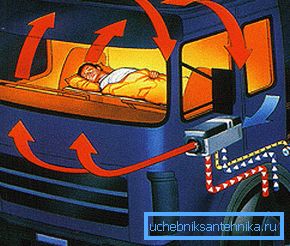
Operating principle
The scheme of operation of automotive heating equipment operating on gasoline or diesel fuel is extremely simple. The device draws cold air from one side and blows the heated from the outlet pipe located at the opposite end of the casing. Due to the constant circulation of air masses, the room is heated.
The equipment can be part of the vehicle’s on-board system (the fuel is supplied from the car’s tank), and can also function fully autonomously (in this case, an individual tank with gasoline or diesel fuel will be needed).

Management can also be made both from the dashboard of the vehicle, and separately.
The advantages of using an air heater for heating the passenger compartment or the car body are undeniable:
- raises the air temperature much faster than the standard built-in stove;
- contributes to significant savings of resources, as it consumes from 0.1 to 0.5 liters of fuel per hour;
- absolutely safe to use, releases less harmful substances into the atmosphere.
Note! The efficiency of using the described systems is so high that many manufacturers of motor vehicles embed autonomous climatic equipment in the manufacture of machines. An example is the Webasto air heater, which can significantly reduce the amount of harmful emissions into the atmosphere and increase the efficiency of the operation of freight transport.

The functioning of the autonomous heater does not depend on the brand and manufacturer of the equipment.
The work is as follows:
- receipt of a signal about the beginning of work from the operator (driver);
- testing the performance of systems and mechanisms;
- the inclusion of a fan that provides air to the combustion chamber;
- the inclusion of a fuel pump that supplies fuel to the same;
- ignition of the mixture, which will heat the pumped air;
- turning on the fan, which takes cold air and transfers it through the heating chamber.
Upon reaching the desired temperature in the room, the heater switches to its maintenance mode, which requires less fuel and electricity to operate.
Specifications of popular models
Planar
The most widespread in our country was the air heater Planar 4DM-24, which is designed for heating the salons of trucks, semi-trailers, temporary shelters and other similar structures. The peculiarity of this device is that the device operates from a voltage of 24 volts, which is provided by batteries and generators of large machines.

This device for heating is distinguished by the following features:
- High performance. The unit provides up to 4 kW of thermal energy, which allows it to be used as an effective air conditioning system. It can heat up to 120 cu. meters of air per hour, which is the volume of a fairly spacious room. (See also the article Electric heating convectors: features.)
- Efficiency. Unlike the built-in stove, the heater does not require the work of the internal combustion engine of the car and consumes about 0.5 liters of fuel. In addition, the air heater does not load the electrical subsystem of the car, since its work requires only 62 watts of energy.
- Universality. For the operation of the air heater Planar you need standard diesel fuel corresponding to GOST 305-82. You can refuel it at any petrol station.
- Compact. Despite its high performance, the weight of the equipment does not exceed 8 kg with all mounting hardware and other components.
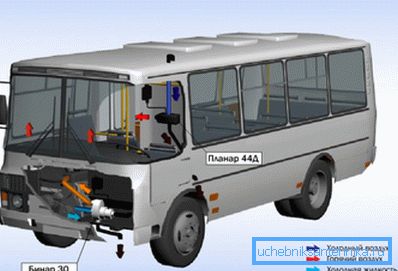
Tip! If you need a less powerful but equally reliable device, pay attention to the air heater Planar 4DM-12. It produces 1 kW of energy and warms up 70 cubic meters of air per hour. At the same time consumes only about 100 grams of diesel fuel and 10 watts of energy. The required voltage of the on-board network is 12 volts (like that of a car battery).
Airtronic
An alternative model of Planar is the AirTronic D2-diesel air heater manufactured by Eberspächer. It allows you to effectively heat the cargo road transport, construction and other engineering equipment, as well as large-tonnage mechanisms.
All the necessary fittings are included in the package, so you will not have to incur additional costs for the purchase of brackets, adapters, hoses, and so on, the price of which is rather high.

The advantage of this device is that its operating parameters can vary in a wide range, allowing you to choose the most economical and efficient heating mode.
Adjustments are subject to:
- degree of heating (there are four modes: from maximum to small);
- heating power (varies from 2200 watts to 850 watts);
- air consumption (the device can pump from 90 to 36 cubic meters);
- fuel consumption (depends on other modes of operation and ranges from 0.28 - at the maximum to 0.10 at the minimum).
The Eberspeher air heater will help to economically heat the cabin during parking, provide the necessary storage mode for the cargo being transported and make it easier for the engine to start at a low outside air temperature.
AirTronic heater:
- provide quick ignition in winter;
- economical fuel consumption for heating;
- easy to install and operate.
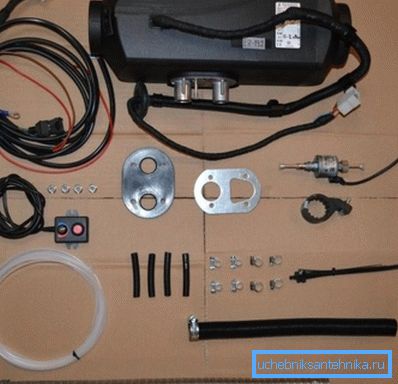
Independent installation of an autonomous air conditioner
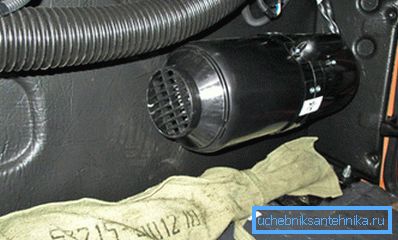
Immediately it should be noted that the instructions for installing an air heater do it yourself is quite complicated and has many nuances.
You need to do the following:
- choose a place in the passenger compartment or the car body (a temporary house or a construction trailer) where an additional air heater will be installed;
- provide access to the fuel tank or install a separate tank and piping with a filter that is necessary to supply gasoline or diesel fuel to the heater;
- protect equipment from moisture and dirt, which are formed during the operation of vehicles;
- fix the equipment, while respecting the angles of inclination recommended by the manufacturer;
- to give the heater greater stability, it is recommended to use washers and rubber (depreciation) gaskets;
- install pipelines for supplying cold air and extracting heated air masses;
- make a trial commissioning of the system and make sure that it is working in all possible modes;
- make final adjustment.
Tip! It is advisable to entrust the installation of the heater to a service center employee where the vehicle is serviced. He will carry out the installation of high quality and issue a warranty card for the work carried out. In the event of a breakdown, you can get a refund for a damaged heater.
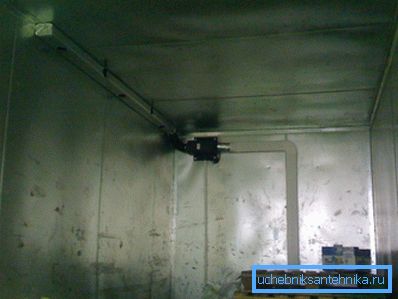
Conclusion
Despite the fact that cars are most often equipped with a standard heating system, it is advisable to equip them with autonomous air heaters. They allow more economical use of fuel and maintain the efficiency of the internal combustion engine in the winter.
And you can learn about the use of such systems in temporary houses and other similar facilities from the video presented below.